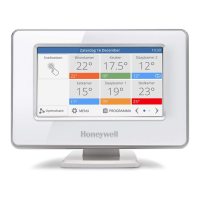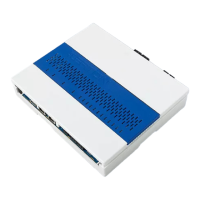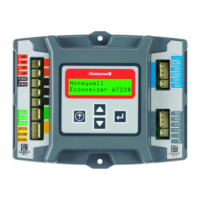ENGINEERING MANUAL OF AUTOMATION CONTROL
BUILDING AIRFLOW SYSTEM CONTROL APPLICATIONS
271
Where:
Pw = Wind pressure in inches of water column
(in. wc)
Cw = Dimensionless pressure coefficient ranging
from –0.8 for leeward walls through 0.8 for
windward walls
Kw = A coefficient, 4.82 x 10
-4
, for air density of
0.075 lb/ft
3
V=Wind velocity in miles per hour (mph)
EXAMPLE:
For a wind velocity of 25 mph and a pressure coefficient of –
0.8 (leeward side), the wind pressure on the building is as follows:
Pw = –0.8 x (4.82 x 10
-4
) x (25)
2
= –0.241 in. wc
STACK EFFECT
Stack effect or thermal buoyancy is the difference between
indoor and outdoor temperature which causes a pressure
difference that affects air movement in a building. Whenever
outdoor air is colder than indoor air, the building draws in air
near the base (infiltration) and expels air near the top
(exfiltration). Conversely, when outdoor air is warmer than
indoor air, the building draws in air near the top (infiltration)
and expels air near the base (exfiltration).
The level of the building at which the differentials of indoor
and outdoor static pressures are equal (with zero wind speed)
is called the neutral pressure level or neutral plane (Fig. 3).
Location of the neutral plane depends on the distribution of
outdoor openings. If one large opening dominates building
leakage, the neutral plane is found close to that opening. For
vertical openings uniformly distributed, the neutral plane is at
midheight. In general, the neutral plane for tall buildings varies
from 0.3 through 0.7 of total building height.
Stack effect can be calculated from the following equation:
Where:
T
o
= Outdoor absolute temperature in degrees
Rankin (˚R) (460 + ˚F)
T
i
=Indoor absolute temperature in degrees
Rankin (˚R) (460 + ˚F)
h=Height of building in feet (ft)
K
s
=Coefficient, 7.46
Rearranging the equation to calculate the differential pressure
results in the following:
EXAMPLE:
Calculate the differential pressure for a 3 ft wide x 7 ft high
door that has a 30-lb opening force, a 10-lb force to overcome
the door closer, and 0.25 ft between the door knob and the
door edge.
Similarly, the maximum pressure difference which overcomes
a 10 lb door closer is as follows:
CONTAINMENT PRESSURIZATION
In an airflow system for a building that requires containment
pressurization, the direction of infiltration is toward the space
with the contaminants. The direction is controlled by regulating
the pressure differentials between the spaces. For example, a
laboratory is typically kept at a negative pressure relative to
surrounding spaces so that any infiltration is into the laboratory.
The static pressure difference required for containment varies
with the specific application. In buildings with areas that require
smoke control, a minimum static pressure difference of 0.02
through 0.04 in. wc is suggested to control cold smoke. (Cold
smoke is generated when water spray from a sprinkler system
cools smoke from a building fire.)
WIND PRESSURE EFFECTS
Wind effects generate surface pressures which can change
supply and exhaust fan capacities, infiltration and exfiltration
of air, and interior building pressure. Wind can affect
environmental factors (e.g., temperature, humidity, and air
motion), dilution ventilation, and control of contaminants from
exhausts.
The pressure exerted by wind on a building surface can be
calculated from the following equation:
Pw = Cw x Kw x V
2
∆
= 0.3358 in. wc
∆p = 0.1679 in. wc
∆P=Pressure difference in inches of
water column (in. wc)
∆P = K
s
x
()
1
T
o
–
1
T
i
x h
∆p =
(F - F
DA
) x [2 x (W –
Kd x W x A
∆p =
(30 – 10 ) x [2 x (3 - 0.2
5.20 x 3 x 21
∆p =
(0 - 10 ) x [2 x (3 - 0.2
5.20 x 3 x 21

